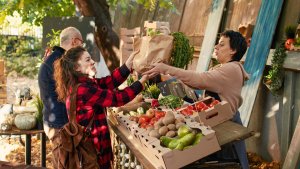Sustainability in the Kitchen
May 22, 2024
By Jolene Weick, Park Interpreter
As the old saying goes, the kitchen is the heart of the home. It is where we nourish our bodies and connect with loved ones over a meal. However, amidst the clatter of pots and pans, it’s easy to overlook the impact our culinary choices have on the environment. Nearly every aspect in our kitchen habits play a role in our relationship with the environment. How, you may ask? Starting with the ingredients we select to star in our dish to the way we consume it, there are steps we can change to make our meal more sustainable. We will cover some simple ways to manage your kitchens environmental impact, starting with reducing the use of aluminum foil.
Aluminum Foil
Aluminum foil can be found in most kitchens, it has many uses and makes clean up a breeze. Unfortunately, our convenience comes at a cost. The production of aluminum takes a significant amount of energy. Approximately 2% of the total supply of energy in the world, is used to create aluminum. To add insult to injury, aluminum foil is single use and non-recyclable. There are alternatives to aluminum foil that have less of an impact on the environment. Try a silicon baking mat instead of lining your tray with foil. If you’re concerned about the top of your food burning while in the oven, try cooking in a Dutch oven. They come in many shapes and sizes to fit your kitchen needs and can often be found in thrift stores, as they’re designed to be long lasting.

Support your local farmer
One of the most obvious ways to bring sustainability into your kitchen, is buying local foods! Going to your city’s farmers market is a great way to find fresh produce, meat, and baked goods. Some farmers even offer cooperatives where you can get a delivery of fresh products weekly. Filling your fridge with locally produced items cuts down on the carbon emissions from transportation, as well as helps out a member of your community. You may even find that your local produce lasts longer in your fridge. By the time our food reaches the grocery store, it has already been handled multiple times and could be weeks old. There are many reasons to eat local foods other than being more sustainable.

Conserve Water
Water is often an overlooked resource. It runs freely from our faucets and is relatively inexpensive. However, freshwater, for many reasons, is becoming scarce all across the globe. One factor that cannot be ignored is the inefficient use of it. Most people take for granted how readily accessible water is, the faucet gets left on for long periods of time, boiling pots are forgotten about, a leak may go weeks without being fixed. Many people also don’t consider the water inside of plastic bottles has no way of getting out if it is trapped. Dumping remaining water from water bottles, pop bottles, and any other capped product can help return water back to its source. Additionally, water used for things such as boiling pasta or vegetables can be used in other culinary dishes, reducing the amount of water that is poured down the drain.
Serving the Season
Walking through a fully stocked grocery store, you may not notice that most of our produce changes origins throughout the year. This is due to the seasons where the product is grown. You may notice an abundance of berries and tomatoes in the summer, apples and squash in the fall, and oranges in the winter. You are still able to get them out of season, they just travel a lot further to get to you. Embracing the seasonality of fruits and vegetables is more than just where they come from, they are fresher, more flavorful, and more nutrient-dense when they are consumed during their season.
Mindful Eating
In today’s world, everyone is moving at a fast pace. There are more fast-food options at a traffic stop than sit-down restaurants. Our relationship with food has changed significantly, we’re OK with “good enough” or “decent”. Eating mindfully offers a way to embrace our palette and create a deeper connection with our food that seems to have been forgotten. If you were to slow down and savor each bite of your food, you may even find new flavors that you weren’t aware of before. Listening to our bodies and eating when we’re hungry, stopping when we’ve had enough, also starts to foster a healthy relationship with food. When we slow down and really think about what we’re putting in our bodies to nurture it, we begin to choose foods that are naturally better for us and better support our well-being.
